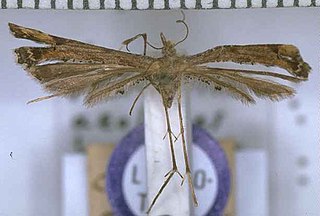
Amblyptilia aeolodes is a moth of the family Pterophoridae. This species was first described by Edward Meyrick in 1902. It is endemic to New Zealand and is found on the Chatham Islands, Big South Cape Island, and the subantarctic Auckland and Campbell Islands.The larvae feed on dicotyledonous herbs.

Amblyptilia epotis is a moth of the family Pterophoridae. It is endemic to New Zealand and is found in the South and Stewart Islands. It inhabits mountainous terrain covered in alpine vegetation or alternatively alpine wetland habitat. The adults of this species are on the wing from February to March. In appearance the adults of this species are variable in colour however this species can be distinguished from similar species by the oblique apical streak on its forewings as well as the patch of white on the costa cilia towards the apex of the forewing.
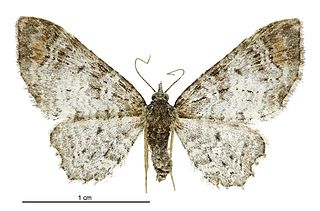
Pasiphila aristias is a species of moth in the family Geometridae. It was described by Edward Meyrick in 1897 and is endemic to New Zealand. This species is found in both the North and South Islands and inhabits subalpine and native forest. Adults are on the wing in December and January and are attracted to light.

Asaphodes albalineata is a species of moth in the family Geometridae. It is endemic to New Zealand and has been observed on Stewart Island / Rakiura. This species is similar in appearance to Asaphodes oraria but can be distinguished as it has an unusual pattern on the underside of its hindwings. It inhabits open hill tops and adults are on the wing in December.
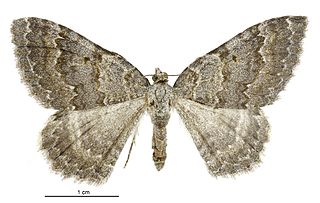
Gingidiobora subobscurata is a species of moth in the family Crambidae. It is endemic to New Zealand. This species has been classified as "At Risk, Declining" by the Department of Conservation.

Asaphodes chlorocapna is a species of moth in the family Geometridae. This species is endemic to New Zealand and can only be found in the Chatham Islands. The larvae of this species consume the leaves of Muehlenbeckia plants. Adults are on the wing in January. This species is classified as "At Risk, Relict'" by the Department of Conservation.

Austrocidaria lithurga is a species of moth in the family Geometridae. It is endemic to New Zealand. This moth is classified as at risk, naturally uncommon by the Department of Conservation.

Xanthorhoe lophogramma is a species of moth in the family Geometridae. It is endemic to New Zealand and if found in the South Island. This species inhabits dry beech scrub but its larval host is unknown. Adult moths are on the wing in January. This species is classified as "At Risk, Nationally Uncommon" by the Department of Conservation.

Asaphodes dionysias is a species of moth in the family Geometridae. This species is endemic to New Zealand and is only known from mountainous areas in Central Otago. It lives in open grassy mountainous habitat at altitudes up to 1750 m. It is also known to live in wetland habitat. The larvae of this species feed on native herbs. The adults of this species are on the wing in January and February. The adult female of the species has reduced wing size in comparison to the male.
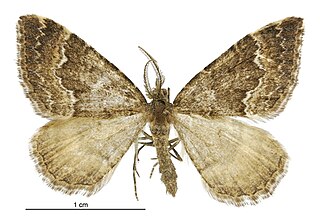
Asaphodes ida is a species of moth in the family Geometridae. It is endemic to New Zealand. This moth can be found in upland or alpine habitat in Canterbury and Otago. Although not classified under the New Zealand Threat Classification system this species is regarded as rare.
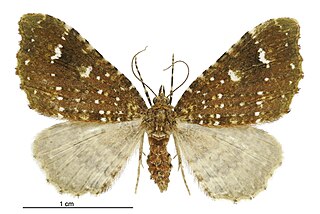
Asaphodes limonodes is a species of moth in the family Geometridae. It is endemic to New Zealand and is found in both the North and South Islands. This species inhabits damp native forest. Adults are on the wing from November until March.

Tingena brachyacma is a species of moth in the family Oecophoridae. It is endemic to New Zealand and has been found in the south of the South Island. This species inhabits open swamps, native forest and scrubland and has been collected amongst Leptospermum. The adults of the species are on the wing in November and December.

Tingena eumenopa is a species of moth in the family Oecophoridae. It is endemic to New Zealand and found in the North and South Islands. The adults have been found amongst tree ferns and are on the wing in December.

Tingena horaea is a species of moth in the family Oecophoridae. It is endemic to New Zealand and have been observed in both the North and South Islands. The adults are on the wing in January.

Tingena pronephela is a species of moth in the family Oecophoridae. It is endemic to New Zealand and is found in the southern parts of the South Island. The species inhabits the outskirts of scrub and native forest. The adults of this species are on the wing from October to February.

Asaphodes nephelias is a moth in the family Geometridae. It is endemic to New Zealand and has been observed in the South Island. The preferred habitat of this species is alpine tussock grasslands above native forest and in wetlands. The adults of this species are on the wing from January to March and are day flying. The female has brachypterous wings.
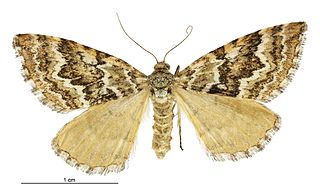
Asaphodes stephanitis is a species of moth in the family Geometridae. This species is endemic to New Zealand and has been observed in the southern parts of the South Island. this species inhabits coastal sand hills and grassland and is regarded as being rare. Adults are on the wing from January to March.
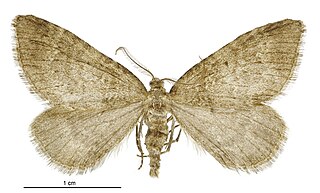
Asaphodes periphaea is a moth in the family Geometridae. It is endemic to New Zealand and has only been collected in the mountains near Lake Wakatipu in the South Island. The male is fuscous coloured sprinkled with whitish colouration. The female is brachypterous. The preferred habitat of this species are alpine bluffs as well as mountainous open country. This species is on the wing from January to March.

Asaphodes prymnaea is a moth in the family Geometridae. It is endemic to New Zealand and can be found on the Mount Arthur tableland. It is common in limestone valleys. The female of the species is paler and has less distinctive markings than the male. Adults are on the wing in January and February.

Asaphodes sericodes is a moth in the family Geometridae. It is endemic to New Zealand and has been observed in the southern parts of the South Island. This species inhabits open tussock grasslands in subalpine scrub or wetlands. The female of the species is likely semi-apterous and is flightless. The adult males are on the wing in January.






















